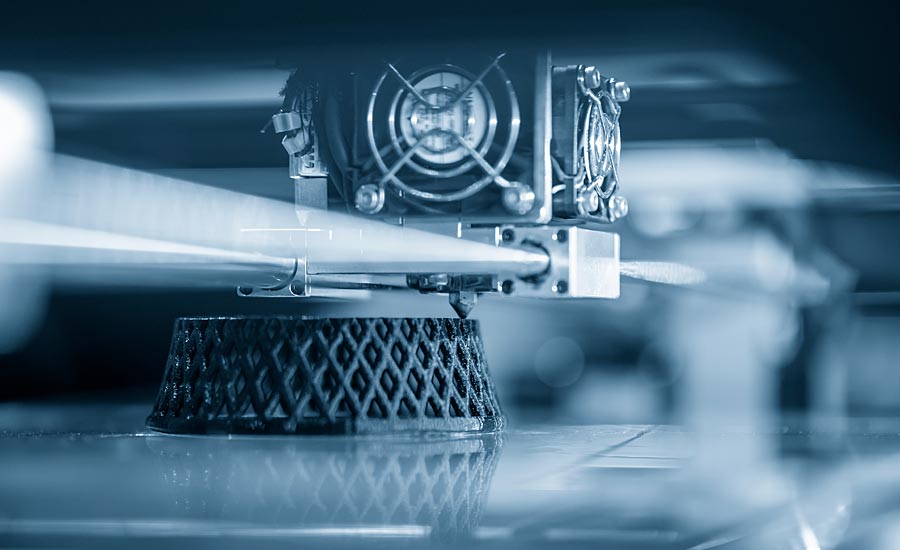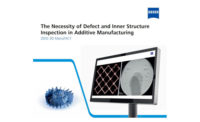While additive manufacturing (AM) makes possible the production of complex shapes and geometries, it should not be treated drastically different than other manufacturing technologies, experts say. Product designers, engineers, and supporting manufacturers should take all the normal and necessary precautions when producing a part to ensure safety and integrity, starting with design.
“We encourage our customers to design their products with the AM application and materials used in mind, clearly identifying critical features to ensure that adequate tests and inspections are performed throughout the manufacturing process,” says Mirza Guzman, director, quality assurance, Stratasys Direct Manufacturing. “Just as one would design for injection molding or CNC machining, it is important to ensure the design accommodates AM as well. While there are far less restrictions than other manufacturing technologies, restrictions remain.”
Additive manufacturing is highly technically diverse. It incorporates many different materials and processing methods. Becoming proficient in these varying production methods enables manufacturers to streamline the manufacturing process, says Chris Peitsch, business development manager, Avonix Imaging.
“The most successful AM producers will efficiently leverage and integrate computational modeling, nondestructive evaluation, in-situ process monitoring, and mechanical evaluation throughout their development and qualification processes,” he explains.
As AM applications are more widely adopted, processes and material specifications, testing and inspection requirements are all gaining importance.
“Customers are interested less in trying to just control the printing process and incorporating a more robust understanding of the full production process, from raw material to final part,” says Guzman.
Additive manufacturing continues to rapidly evolve. Price points are shrinking; large, complex parts are increasingly easy to produce, and manufacturers have become more creative in their designs.
“You now have artificial intelligence and computers modeling different geometries for parts that until now, didn’t exist, due to the difficulty in building them,” says Rahul Alreja of VJ Technologies Inc. “But now with AM, those really complex shapes become truly possible.”
Manufacturers are increasingly interesting in learning more about their parts, says Alreja. They’re inspecting more parts per day and pushing for more efficiency in the manufacturing process.

Source: Phuchit / iStock / Getty Images Plus via Getty Images.
“More. In one word, that’s the trend,” Alreja says. “As the technology for AM and inspection evolves—especially given GPUs and raw computing horsepower to process and crunch data, and artificial intelligence and machine learning algorithms to spot trends— manufacturers from every industry are pushing for more inspection.”
As additive manufacturing grows in popularity, engineers are becoming more educated in its specifics.
“This added knowledge has guided many engineers away from some of the more basic NDT methods and into advanced methods such as computed tomography,” says Camaron M. Lemmer of North Star Imaging Inc.
Inspection challenges arise with the increasing size and complexity of additive parts, Lemmer says.
“This will inherently continue to become more complicated as we progress through printing technology capabilities,” he says. These range from powder bed fusion, directed energy deposition and beyond, he says.
Additive manufacturing’s advantage is that it simplifies things. It reduces part assemblies to single parts, Lemmer says.
For example, something as simple as a bracket might ordinarily involve the creation of multiple parts and complex assembly. Additive manufacturing enables engineers to print a full bracket in one piece. However, common material testing methods such as liquid penetrant testing for surface flaws or ultrasonics for internal flaws won’t work as well.
Computed tomography (CT), however, can completely detect flaws on a 3D presentation and is volumetrically accurate, Lemmer says.
“When these other NDT methods [fail], computed tomography really starts to shine,” Lemmer says.
Peitsch agrees.
“I may be biased, but I really do believe that X-ray computed tomography is one of the most versatile NDE techniques out there in AM,” he says. “It should be a staple technology in any large AM operation. It may not always be the fastest method for every application, but it provides simple visual data that can be interpreted as-is.”
Computed tomography reveals a 3D representation of scanned parts, without requiring any special interpretation, he says.
“And in many cases, the datasets are highly underutilized,” he adds. “There is so much quantitative data available. For example, with looking at defects, a vendor may pass or fail a part based on its total void content (percentage by volume). However, there is also information about each individual pore: its size, shape, and location. These data can be used to unlock valuable information about the AM process, and further improve a vendor’s materials and process. In addition, X-ray computed tomography can also be used to essentially validate other methods of NDE and process monitoring, such as ultrasound and thermal imaging.”
Although complex inspection methods, particularly for metal AM parts, such as CT scanning, CMM, X-ray, fluorescent penetrant inspection, and metallographic inspection, among other methods, are growing in popularity, there is still reliance on destructive testing via material samples built alongside AM parts, Guzman says.
However, technology is advancing rapidly, she says.
“Today we can include more prominent in-situ, or in-process monitoring to help identify defects, and potentially even course correct, during the build,” she says. “More automated, detailed 3-D scanning is also a key component for rapid inspection of critical features.”
Peitsch says that nondestructive testing and in-situ process monitoring should not be viewed as competitors.
“All these different technologies should be viewed as complementary to one another, working towards a single purpose,” he says. “The fusion of all these datasets together will be where the real breakthroughs are discovered. And in the in coming years and decades, I believe that artificial intelligence will be fully embedded into these processes, from material qualification all the way through final component acceptance.”
Guzman says that the field could benefit from industry standards that are specific to AM inspection.
“As customers educate themselves on additive manufacturing, they are allowing us more input into their drawings and designs,” Guzman says. “This partnership between the manufacturer and the service bureau leads to better results in the end.”



